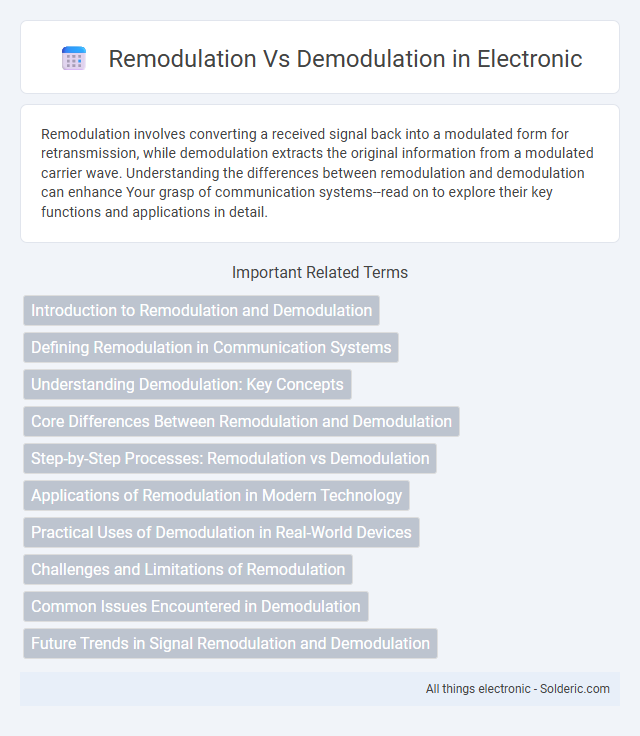Remodulation involves converting a received signal back into a modulated form for retransmission, while demodulation extracts the original information from a modulated carrier wave. Understanding the differences between remodulation and demodulation can enhance Your grasp of communication systems--read on to explore their key functions and applications in detail.
Comparison Table
| Feature | Remodulation | Demodulation |
|---|---|---|
| Definition | Process of modulating a signal again after initial demodulation. | Process of extracting original information from a modulated carrier signal. |
| Purpose | Signal conversion or retransmission with altered modulation formats. | Recover transmitted data from received signals. |
| Use Case | Signal processing in repeaters, frequency translation, or format change. | Receiver end in communication systems to decode signals. |
| Output | Modulated signal ready for transmission. | Baseband or original data signal. |
| Relation | Occurs after demodulation in signal chain. | Occurs before remodulation or data processing. |
Introduction to Remodulation and Demodulation
Remodulation involves converting a demodulated signal back into a modulated form for transmission or processing, optimizing signal integrity and compatibility with communication systems. Demodulation extracts the original information-bearing signal from a received modulated carrier wave, enabling data interpretation and further processing. Both processes are fundamental to digital and analog communication systems, ensuring accurate signal transmission and reception across various media.
Defining Remodulation in Communication Systems
Remodulation in communication systems involves converting a demodulated signal back into a modulated form for retransmission or further processing, ensuring signal integrity across multiple transmission stages. This process requires precise synchronization and carrier frequency alignment to maintain data accuracy and minimize distortion during signal conversion. Remodulation is essential in relay stations, repeaters, and digital communication networks to enhance signal strength and extend coverage areas.
Understanding Demodulation: Key Concepts
Demodulation is the process of extracting the original information-bearing signal from a modulated carrier wave, essential for interpreting transmitted data in communication systems. Understanding demodulation involves recognizing how different techniques, such as amplitude, frequency, or phase demodulation, recover audio, video, or digital data from modulated signals. Your ability to grasp these key concepts enhances effective signal processing and ensures accurate decoding of transmitted messages.
Core Differences Between Remodulation and Demodulation
Remodulation involves converting a demodulated baseband signal back into a modulated carrier wave for retransmission, whereas demodulation extracts the original information signal from a modulated carrier. The core difference lies in their directional process: demodulation decodes the received signal, while remodulation prepares the signal for sending by re-encoding it. These processes are essential in communication systems for signal processing, with demodulation facilitating data reception and remodulation enabling signal forwarding.
Step-by-Step Processes: Remodulation vs Demodulation
Demodulation extracts the original signal from a modulated carrier by detecting changes in amplitude, frequency, or phase through a sequence of signal filtering, envelope detection, and decoding steps. Remodulation involves taking a baseband signal, converting it into a modulated waveform by applying a carrier frequency, and adjusting parameters such as amplitude or frequency to prepare it for transmission. The demodulation process reverses modulation effects to retrieve data, while remodulation transforms received or processed signals into a new modulated form for further transmission or processing.
Applications of Remodulation in Modern Technology
Remodulation plays a crucial role in modern communication systems by enabling the efficient adaptation of signals for different transmission environments, such as satellite and digital broadcasting. It facilitates signal processing techniques like error correction and bandwidth optimization, enhancing data integrity and transmission quality. Applications of remodulation are evident in wireless networks, cable TV distribution, and digital video broadcasting, where signals are often converted and retransmitted to maintain compatibility and performance.
Practical Uses of Demodulation in Real-World Devices
Demodulation is crucial in extracting original information from modulated carrier signals, commonly used in devices like radios, televisions, and wireless communication systems for clear audio and video transmission. You rely on demodulation processes in smartphones and satellite receivers to convert received signals into usable data, enabling seamless connectivity and media streaming. These practical applications highlight demodulation's role in ensuring accurate and efficient signal interpretation in everyday technology.
Challenges and Limitations of Remodulation
Remodulation faces challenges such as signal degradation and increased noise accumulation, which can reduce overall transmission quality. Limitations include the complexity of maintaining signal integrity across multiple modulation stages and the potential for synchronization issues in communication systems. Your system's performance might be affected by these factors, requiring advanced error correction and precise timing mechanisms.
Common Issues Encountered in Demodulation
Common issues encountered in demodulation include signal distortion, noise interference, and synchronization errors, which can degrade the accuracy of the recovered data. These problems often arise due to multipath fading, phase shifts, and inadequate filtering during the demodulation process. Ensuring proper synchronization and using error correction techniques can significantly improve your signal integrity and overall communication performance.
Future Trends in Signal Remodulation and Demodulation
Future trends in signal remodulation and demodulation emphasize the integration of AI-driven algorithms to enhance signal clarity and reduce latency in 5G and beyond networks. Advancements in adaptive modulation schemes enable real-time optimization of bandwidth and energy efficiency, crucial for IoT and edge computing applications. Quantum signal processing techniques are emerging, promising unprecedented accuracy and security in communication systems.
remodulation vs demodulation Infographic

 solderic.com
solderic.com